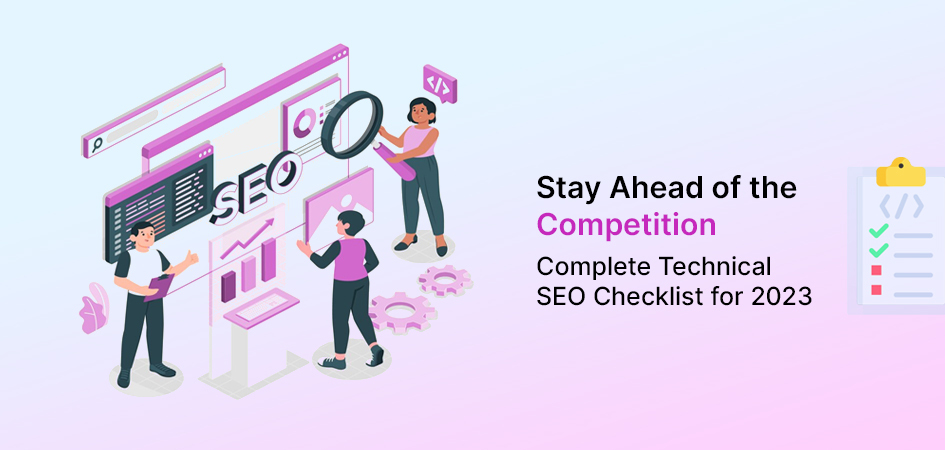
While optimizing the site with SEO, people often focus on On-page and Off-page SEO. Overlooking one essential aspect of SEO, “Technical SEO,” which focuses on making your site easy for search engines to crawl and index on search engine result pages (SERP).
This is why your site needs to be technically optimized. In this blog, we will check out technical SEO, a checklist to make your site technically optimized, and how it is different from on-page SEO.
What is Technical SEO and Why it is Important?
Technical SEO refers to the optimization of a website’s technical aspects to enhance its search engine visibility and performance. It involves improving your site’s elements like website speed, mobile-friendliness, crawl ability, indexing, site structure, and schema markup. All this helps you lay the foundation for successful organic search rankings.
Technical SEO is very important to enhance user experience. By optimizing technical elements of your site, such as XML sitemaps, schema markup, and robots.txt files, which assures effective indexing and crawling of your site on SERP.
Also, It includes optimizing your site’s loading speed, making the site responsive, and mobile optimization contributes to positive user engagement, reducing bounce rates, and increasing conversions.
Furthermore, technical SEO also supports other SEO efforts. It helps search engines better understand website content, improves website accessibility for all users, and enhances the overall performance of your site website.
Checklist for Your Technical SEO Journey
Optimizing your site with technical SEO can be a little tricky, but if you have a checklist or a roadmap beforehand makes it easy for you to execute. So here are 5 essential things that one should keep in mind while doing technical SEO.
-
Website Speed Optimization
Website Speed Optimization is a technical SEO practice that focuses on improving the loading speed and performance of your website. This involves optimizing various elements that affect your website page speed, such as image optimization, minifying code, caching, reducing server response time, and using a content delivery network (CDN).
A faster website not only improves user experience but also boosts search engine rankings, as Google considers page speed as a ranking factor. Slow-loading websites can lead to high bounce rates, low engagement, and lost conversions. Website Speed Optimization is essential for improving your website traffic, engagement, and revenue.
-
Mobile-Friendliness
Mobile Friendliness is very important as most people search keywords on their phones these days. You should optimize your site’s layout and design that adapts to various screen sizes and resolutions. You should implement responsive design principles and fluid grids to deliver an exceptional user experience on mobile devices. Prioritize fast loading speeds, intuitive navigation, and touch-friendly elements to engage mobile users.
Leverage mobile-friendly plugins and optimize images for efficient mobile rendering. Don’t overlook mobile SEO; Google’s mobile-first indexing prioritizes mobile-friendly websites, catapulting you to the top of search results. Stay ahead of the curve by embracing mobile friendliness and watch your online presence soar to new heights.
-
XML Sitemap and Robot.txt
XML Sitemap and robots.txt are crucial elements of technical SEO. XML sitemap helps search engines understand the structure and hierarchy of your website by listing all the pages. It improves indexing and crawling efficiency, ensuring all relevant content is discovered.
On the other hand, robots.txt acts as a guide for search engine crawlers, instructing them on which parts of your site to access or exclude. It helps prevent the indexing of sensitive or duplicate content. Properly configuring these files can enhance your website visibility and search engine rankings. Regularly updating sitemaps and ensuring robots.txt directives align with SEO goals is essential for optimal website performance.
-
Website Security
Website security protects your site from cyber threats and ensures a safe and trustworthy user experience. Implementing SSL/TLS encryption safeguards sensitive data transmitted between the user and the site, boosting trust and search engine rankings. Regular security audits, vulnerability scans, and malware detection ensure proactive protection.
Additionally, using strong passwords, keeping software up to date, and employing firewalls and intrusion detection systems support security. Preventing hacking attempts, data leaks, and malware infection. Safeguards also help your website preserve its reputation, user trust, and search engine visibility.
-
Structured Data Markup
Structured data markup helps in technical SEO by enhancing the visibility and relevance of website content to search engines. By implementing structured data markup using schema.org vocabulary, you provide search engines with valuable context about your content.
This allows them to display rich snippets, knowledge graphs, and other enhanced search results. Structured data improves your user experience by providing quick access to key information, such as product details, ratings, reviews, event dates, and more. It also increases click-through rates and drives targeted organic traffic, ultimately boosting your search engine rankings and maximizing the impact of your SEO efforts.
How is Technical SEO Different From On-Page SEO?
Technical SEO and on-page SEO are two different aspects of search engine optimization, each playing a crucial role in improving your website’s visibility and rankings.
Technical SEO focuses on optimizing the technical elements of your website to ensure it is easily accessible and understandable by search engines. This includes optimizing your site structure, URL structure, metadata, schema markup, sitemaps, canonical tags, redirects, page speed, mobile responsiveness, and accessibility. Technical SEO helps search engines crawl, index, and rank your website, which increases online visibility, traffic, and conversions.
On the other hand, On-page SEO involves optimizing your web pages to target specific keywords and improve your relevance and quality. It includes optimizing title tags, meta descriptions, headings, content quality, keyword usage, internal linking, and user experience. On-page SEO aims to make your web pages more appealing to both search engines and users, increasing your visibility and click-through rates in search results.
In simple words, technical SEO focuses on the technical aspects of your website to improve its accessibility and indexability, while on-page SEO focuses on optimizing your web pages to enhance your relevance and appeal to search engines and users. Both are essential components of a proper SEO strategy.
Conclusion
Technically Optimizing your site can be challenging for many people. It is essential to make a checklist beforehand to make sure you don’t forget any important part of technical SEO.
The checklist given in the blog covers all the crucial parts of technical SEO, which makes your site easier to crawl and index on search engines.
Want to Technically optimize your site? Willshall Consulting will be the most suitable choice for you. As our professionals provide different local SEO servies.

I bring a wealth of knowledge and experience to WillShall Consulting with two decades of expertise in Website Design, Development, and Digital Marketing, My journey has been marked by a passion for creating innovative web solutions that not only meet but exceed client expectations. As an avid analyst, I dedicate myself to understanding each customer’s unique needs, ensuring that our web solutions are not just functional but exceptional.









